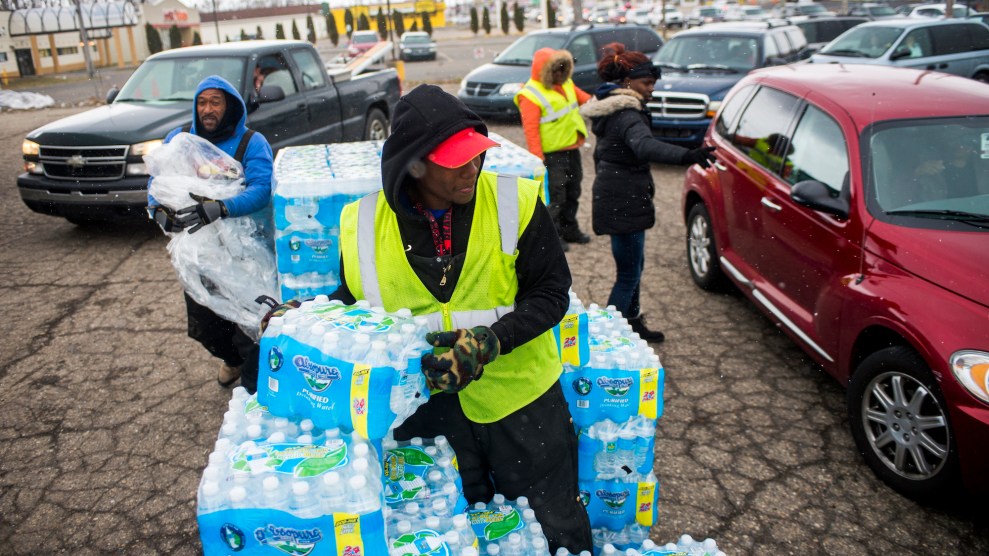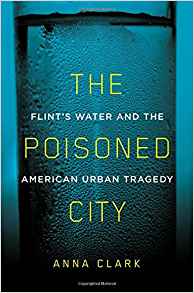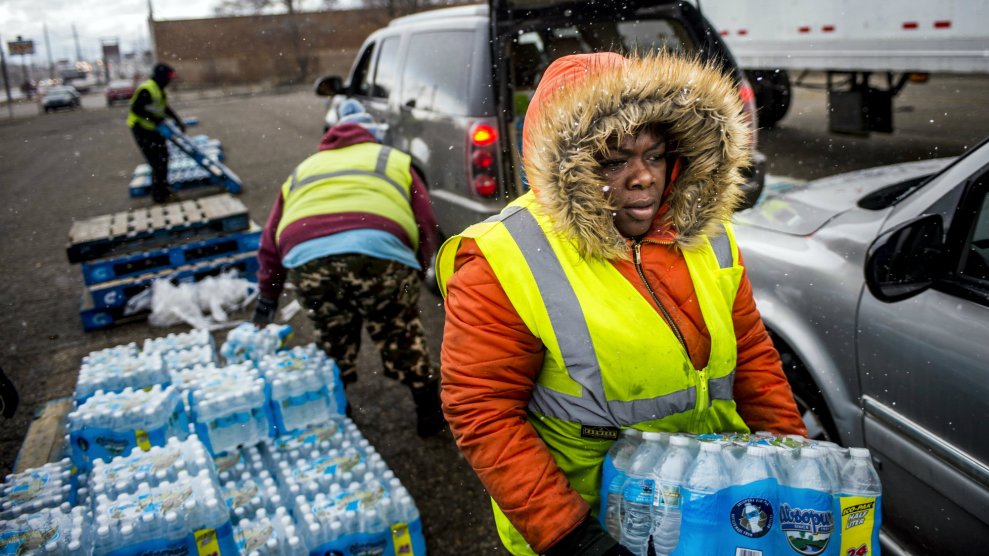
Jake May/The Flint Journal-MLive.com via AP
You may think you know the story of what happened in Flint, Michigan. When Flint, under the direction of a state-appointed emergency manager, switched its water supply from Lake Huron to the Flint River in 2014, the people in the mostly lower-income, black city almost immediately began noticing problems—discoloration, unexplained rashes, and illnesses. It took another year-and-a-half for state officials to begin to acknowledge that something was seriously amiss, and that was only after a groundswell of community activism and local reporting shed light on the full extent of the lead-poisoning crisis. Even today, it is still impossible to know the full extent of long-term harm inflicted on children and other vulnerable populations from the contaminated water.

That story is well-known, but there are two new books out that tell an even more complicated tale. The first is What the Eyes Don’t See, by Flint pediatrician Mona Hanna-Attisha. It is the doctor’s personal account of how she and other community members and activists became whistleblowers for the public health crisis, alerting the country to how local children in the city had suffered from lead poisoning.
The second is Michigan journalist Anna Clark’s investigative account, The Poisoned City, in which she focuses both on the various public and private figures who became central to the Flint narrative, and also the institutional factors that set the stage for the crisis. Clark is a freelance writer who lives in Detroit and has covered the water crisis since late 2015. She examines how disinvestment in city infrastructure, racial discrimination, political interests, suburban sprawl, and an emergency management system unique to Michigan, all came together to contaminate the water Flint’s residents drank.
Even though Michigan ended its free bottled-water program earlier this year, the city’s corroded pipes are undergoing replacement, and residents still don’t trust the state when it says the water is safe. I interviewed Clark in late June to learn more about her perspective on the crisis.
Mother Jones: Flint became a kind of political football, especially in the 2016 election. It was fascinating to see how you looked beyond the politics and into the historical racism and disinvestment in cities and argued that all these factors created a perfect storm that led to this crisis.
Anna Clark: Even though much about the history is very unique there, people recognize the phenomenon of a core legacy city that is shrinking in population and has a majority of people of color. There are very explicit decisions made throughout the 20th century that facilitated this kind of disinvestment, and they’re directly related to race and segregation, to the rise of fair housing and school desegregation laws. It prompted a mass exodus of people from core cities that were supported by federal investment programs that made the suburbs places to move. In other ways they were able to create this de facto segregation that had been in place in the cities. And so they set the cities up to fail.
MJ: How does this apply to Flint?
AC: This is sort of like an extension of the redlining practices of the past. Infrastructure in these communities is crumbling. In this shrinking population there’s a water system that is designed to serve twice as many people as there are there today, but it is has half the people paying into it. Large water mains were built to sustain this huge industrial sector they had hoped would keep growing. Not only is this a downward spiral for the community trying to sustain itself and to provide people with basic needs, but it also directly led to the water being even more contaminated. So the water was not treated appropriately in the first place; it would also sit stagnant in these overly large pipes that are traversing a lot of vacant structures so that lead and other contaminants can become more concentrated. By the time it reaches somebody, it’s in even worse shape. It was part of why the denser neighborhoods in Flint were less likely to have water from corroded iron than communities with a lot more vacant spaces. These are all intersecting issues.
I write mostly about cities and I think part of this experience has been helping me see that these are the same things, and the stories are both about place and people and consequences. I think that cities like Flint are set up to fail and it’s incredibly frustrating when—if there are any policy responses to it—it’s framed as, “You folks can’t lead yourself.” Which is also pretty racially coded. That’s part of what made it catch attention; the city did not have power over its own decisions.
MJ: Your book has to stop at some point, and I noticed that it doesn’t really get into the effects, if any, of the Trump administration, and the EPA’s role in making sure Flint’s water is safe. Do you think there has been an impact?
AC: I don’t know. Maybe that’s part of why it’s not there. There have been these pending, ever-delayed revisions to the lead and copper rule, which is kind of amazing because it has been several years in play. I think what happened in Flint raised a lot of awareness about the limitations and loopholes within that federal guideline, ones that affect not just poor and majority people of color communities all over the country. Officials have been exploiting in a way that makes the water appear safer than it is.
And that also belies the fact that there’s no federal regulation that schools or child care centers need to be tested. Despite the fact that children are most affected, there’s no maximum contaminant level for any individual home. So your own home might have an outrageous amount of lead in the water, and up to 10 percent of other households in your community can also have outrageous amounts of lead in the water. According to the federal guidelines, that won’t lead to the level of taking action. It masks the urgency of what we really need to do which is to get lead out of our drinking water system—that is of course incredibly complicated and expensive but there really is no other way.
MJ: Is there anything that federal or state governments can do?
AC: One thing an administration committed to a war on lead could do is [revise] the lead and copper rule. Just this week, Michigan has publicized the fact it’s just passed what it’s calling the toughest lead and copper rules in the nation. It’s not as tough as many activists would like it to be, but it is better than it used to be. And it also does serve as a reminder that the federal regulations are designed as a minimum. States can be tougher.
Why don’t we use that also as an opportunity to do a full analysis of lead sources within the home and in yards, as opposed to treating everything like a siloed problem? And maybe our responses should be more intersectional to just acknowledge how environmental contaminants actually play out in our lives.
MJ: The Michigan governors’ race is interesting. Have there been community reactions in Flint, or a lot of interest, since it involves many of the players who had some role in the Flint crisis?
AC: I think that the Flint story is a pretty huge factor in the governor’s race right now. On the Republican side, is Bill Schuette, the attorney general, who has decided that his office is taking a role in both the defense and prosecutions of the Flint water case—which itself is pretty weird but it’s true. On the Democratic side there are probably two leading contenders. One is a long-time legislator and another is a physician who led Detroit’s health department for a time. Both have made water issues a big part of their campaigns. There is such deep level of broken trust here, that it does take more than campaign proposals to win that trust back.
MJ: A basic, or come to think of it maybe not-so-basic question, concerns the water quality for Flint now. Is it safe?
AC: It actually is a harder question than you might think, because who do we trust? This is part of the legacy of the water crisis. The short story is in April the state discontinued the bottled water distribution, citing a couple rounds of tests that show that lead levels were normal—by normal they mean not so much worse than every other community. Residents were pretty outraged by this, and that includes some folks in the medical community and water professionals. First of all, lead isn’t the only thing that people were concerned about with the water in Flint. There’s also the Legionnaires’ outbreaks and summer’s coming up. There is ongoing work to replace the pipes although that won’t be done until 2020. There’s a lot of research that suggests that when you do that kind of disruption underground, it tends to shake out lead in the system. And so most people felt that the bottled water distribution should have continued until that was finished.
Just within the last week the Michigan Department of Environmental Quality said that if you don’t fix these, we’re going to sue [Flint] because we don’t have faith that you can do the job effectively. You’re getting these mixed messages from state officials. On one hand, they say the water is safe enough that we don’t need distribution of bottled water. On the other hand we don’t have faith in your capacity to treat it to the point we’re willing to sue you.
It’s kind of a fraught place right now. What’s happening is that a lot of folks are going back to the days of doing their own bottled water drives to support each other, homebound neighbors, seniors, people who are more vulnerable, and are cautious about the water use themselves.
MJ: When I started reporting this story in late 2015, it was baffling to figure out who is to blame and why did this happen? And obviously it is really complicated. What can be done to restore trust?
AC: The state needs to acknowledge that it needs to take time to earn and be worthy of this trust right now.After the water crisis the state has to show it understands the deeper root of its problem and negligence of the city. But two of the top people who face criminal charges, quite serious ones, are still in their jobs, running an agency that’s responsible for the long-term recovery efforts in Flint. I think people are waking up to the fact that maybe the number one priority of our environmental public servants is not the environment or public health.
I think another thing that happened with Flint, part of its legacy, is that some things that seem clearly wrong are not necessarily illegal. That’s something we need to wrestle with a little bit more, like maybe there are some things that should be illegal. Or how do you do environmental science? I think it was wrong not having access to a lot of that information, because of the transparency laws in Michigan. That is a serious long term issue affecting not just people who care about the environment, and the water, but a lot of things. That culture of secrecy is what fuels crises like these.
Our legal system isn’t quite caught up to how environmental cases work. They also have a real issue where motives can be foggier. Another reason why a lot of class action cases against the lead industry have not always been successful is because it’s really difficult to “prove” that someone’s symptoms or someone’s illness was not just related to lead but related to lead from your particular product, right from your particular source. All of this is combined to make accountability a very slippery thing.
My hope is that however it succeeds, or doesn’t only succeed but it galvanizes people to reflect. How do we find accountability within the justice system? How do we make it possible for people who are affected by situations like these? It isn’t just Flint. It won’t just be Flint.
This interview has been edited for clarity and length.
















